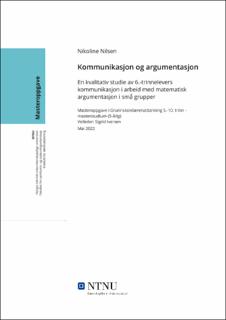| dc.contributor.advisor | Iversen, Sigrid | |
| dc.contributor.author | Nilsen, Nikoline | |
| dc.date.accessioned | 2022-07-14T17:21:27Z | |
| dc.date.available | 2022-07-14T17:21:27Z | |
| dc.date.issued | 2022 | |
| dc.identifier | no.ntnu:inspera:107175740:30318335 | |
| dc.identifier.uri | https://hdl.handle.net/11250/3005613 | |
| dc.description.abstract | Denne studien har undersøkt elevgruppers kommunikasjon i deres arbeid med å bevise en påstand. Formålet med studien har vært å bidra med mer kunnskap rundt elevers argumentasjon og hvordan interaksjonsmønster i grupper kan si noe om graden av samhandling mellom elevene. Der av også for å kunne gi innsikt i sammenhenger mellom argumentasjonsformer og interaksjonsmønster i grupper. Studiens forskningsspørsmål er: Hva kjennetegner kommunikasjonen i tre smågruppers arbeid med argumentasjon på 6. trinn?
Studien har benyttet en kvalitativ metode og består av observasjon av ni elever fordelt på tre grupper. Påstanden elevene skulle argumentere for omhandlet summen av tre påfølgende tall og delelighet. Elevgruppene arbeidet alene uten noe støtte fra meg eller andre lærere og det ble heller ikke gitt noen undervisning rettet mot tema i forbindelse med studien. Datamaterialet består av transkripsjoner av elevgruppenes samtaler. De ble analysert ved hjelp av deduktiv analyse med kategorier fra G. Stylianides (2008) sine argumentasjonsformer og et interaksjonskart inspirert av Sfard og Kieran (2001), som ble brukt til å si noe samhandlingen mellom elevene i de tre gruppene. Disse rammeverkene tar utgangspunkt i det sosiokulturelle læringssynet, der elevenes felles deltakelse i gruppen ble analysert.
Studien viser hvordan elevene argumenterer og samtidig hvordan interaksjonen i gruppene foregår, noe som kan gi grunnlag for refleksjon om undervisningspraksis. Resultater fra studien viser at elevene bruker eksempler som støtte i prosessen med å argumentere. I all hovedsak brukes eksemplene til å argumentere empirisk, selv om flere av elevene forstår begrensningene ved denne typen argumentasjon. Resultatene viser også at en elev gjentatte ganger produserer et generisk eksempel for å bekrefte gyldigheten til påstanden. Til tross for at denne eleven argumenterer generisk, indikerer studien at elevene generelt har liten kjennskap til hvordan de kan produsere gyldig argumentasjon for å bekrefte eller avkrefte en påstand. Studien viser også sammenhenger mellom elevgruppenes argumentasjonsformer og interaksjonsmønster. Eksempelvis at tilsynelatende høy grad av samhandling i gruppen ikke nødvendigvis betyr at det matematiske innholdet i samtalen er produktivt. | |
| dc.description.abstract | This thesis has examined student groups’ communication in their work to prove a statement. The purpose of the study has been to contribute more knowledge about students’ argumentation and how interaction patterns in groups can say something about the degree of interaction between students. Combining these perspectives provide insight into the connections between forms of argumentation and interaction patterns in groups. The study’s research question is: What characterises the communication in three small groups working with argumentation in 6th grade?
The study has used qualitative methods, consisting of observation of nine students divided into three groups. The statement the students were to argue about referred to the sum of three consecutive numbers and divisibility. The student groups worked alone without any support from the teacher or me, and the students had not worked with argumentation explicitly before the study. The data material consists of transcripts of the student group’s conversations. They were analysed using deductive analysis with categories from G. Stylianides' (2008) forms of argumentation and an interaction map inspired by Sfard and Kieran (2001), which was used to analyse the interaction between the students in the three groups. These frameworks are based on the sociocultural view of learning, where the student’s joint participation in the group was analysed.
The study shows how the students argue and, at the same time, how the interaction in the groups takes place, which can provide a basis for reflection on teaching practice. Results from the study show that students use examples as support in the process of arguing. The examples are mainly used to argue empirically, although several of the students understand the limitations of this type of argumentation. The results also show that a student repeatedly produces a generic example to confirm the statement’s validity. Even though this student argues generically, the study indicates that students generally have little knowledge of creating valid argumentation to confirm or deny a statement. The study also shows connections between the student groups’ forms of argumentation and interaction patterns. For example, the seemingly high degree of interaction in the group does not necessarily mean that the mathematical content of the conversation is productive.
| |
| dc.language | nob | |
| dc.publisher | NTNU | |
| dc.title | Kommunikasjon og argumentasjon | |
| dc.type | Master thesis | |
